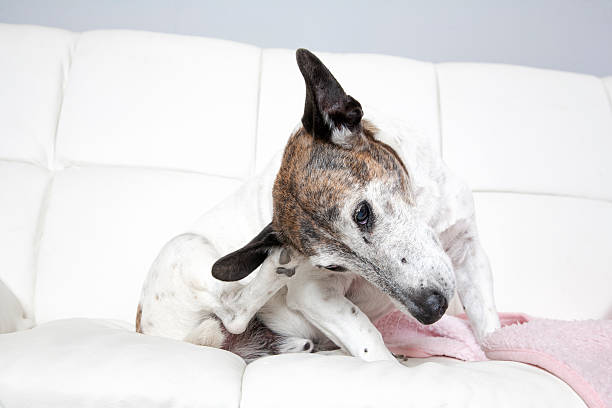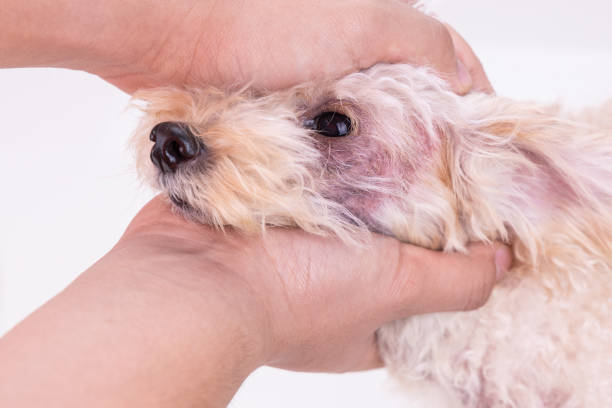Many dogs might encounter eye infections at certain stages of their lives, which could potentially become severe. The first symptoms could involve unusual tearing or eye redness, but if not appropriately treated, it could lead to serious conditions such as granuloma or corneal ulcers. Here are six suggestions to prevent your dog from getting an eye infection:
Keep Your Pet’s Face Clean
You should wash their face daily with a wet rag and then dry it off thoroughly. This is especially important if they have been playing outside where dirt and other things could infect them.
Use Saline Solution
The saline solution is an excellent way to keep their eyes moist and clean. Place some saline solution in a spray bottle and then spritz it over their face, allowing it to dry naturally.


Brush Your Pet’s Teeth
If you brush your dog’s teeth every day, they will be less likely to get an eye infection because there will be no bacteria or other materials stuck in their mouth. If you don’t want to do it yourself, then take them to the dentist with regular cleanings.
Feed Your Dog a Healthy Diet
You should provide your pet with a high-quality diet that consists of wholesome ingredients like fresh vegetables and meat instead of fatty foods or chemicals. This is especially important for puppies and younger dogs that are still developing.
Exercise Your Dog
Giving your pet plenty of exercise is essential to produce their natural antibodies. When a dog gets exercise, it releases endorphins which create an anti-inflammatory effect, meaning there will be less chance for infection or other health concerns.
Don’t Over Pet Your Dog
When you touch and pet your dog, they will be more inclined to lick their paws and face where bacteria may be lurking. This can lead to more infections and other health problems if you give them too much attention.


What are the Symptoms of a Dog Eye Infection?
The most common type of eye infection in humans- conjunctivitis, also known as pink eye- is the same disorder that can affect your pet.
The signs of canine conjunctivitis are excessive tearing, redness, crusting, and swelling. The disorder can lead to complications like granuloma or corneal ulcers if left untreated. Dogs who have an infected attachment to their eye may blink uncontrollably or excessively.
Dogs may also exhibit discharge from their eyes running down onto their nose, mouth, or chin. Swollen underlids are not uncommon in conjunction with other symptoms too. Additionally, you might notice particles forming in the whites of your dog’s eyes that cannot be broken down manually by licking them away.
What Causes a Dog Eye Infection?
There are a couple of factors that can cause a dog eye infection. Here are six common ones:
- Irritation from Collies, Old English Sheepdogs, and Shetland Sheepdog breeds because of their unique shape of the head and eyelashes rubbing against the eyeball itself.
- Constant exposure to cold weather, wind, or wet conditions can cause the eyes to become irritated and develop conjunctivitis.
- Allergies are also a common cause of canine eye infections. If your dog suffers from allergies, he may also be scratching excessively at his face, leading to abrasions and scarring.
- Dogs with facial injuries or those struck by an object can also develop a dog eye infection because of the trauma they experienced on the face and surrounding area.
- Pupillary Sphincter Muscle Dysfunction (PSMD) is another common cause of canine eye infections. This disorder occurs when the pupil sphincter muscle becomes either damaged or diseased, and it then causes an inability to contract with enough force to dilate appropriately.
- Dogs may also develop conjunctivitis because of bacterial, viral, fungal or parasitic diseases that affect the eye area.


Treatment Options for a Dog Eye Infection
Fortunately, a canine eye infection can be successfully treated if diagnosed and treated early. The most common treatment options include the following:
1. Cleansing the affected dog’s eyes with warm water mixed with Betadine or an antibiotic ointment to relieve any pain or itchiness accompanying the infection. You may want to consult your veterinarian before trying these out on your dog, as you also do not want to cause further eye irritation.
2. Eyedrops prescribed by a veterinarian are another option for treating the disorder, particularly if the dog has corneal ulcers or bacterial infections that need immediate attention.
3. Your veterinarian can also prescribe antibiotics if a bacterial infection causes the disorder. Sometimes though, antibiotic drops are not enough, and veterinary assistance may be needed to administer an injection of antibiotics into your dog’s bloodstream. This ensures that the proper medication dosage reaches your pet in all areas of his body.
4. Your vet might also prescribe corticosteroid drops to relieve any pain and swelling the dog may be experiencing.
5. For chronic cases of canine conjunctivitis, your veterinarian may recommend topical antibiotics or anti-fungal medications combined with cleansing the eyes regularly to prevent further contamination or infection.
6. Lastly, your veterinarian may prescribe a sedative or anti-inflammatory medication for very active dogs that won’t cooperate with the treatment process.
Preventing and Getting Rid of Dog Eye Infections
There are several measures you can take to help prevent your dog from developing canine conjunctivitis:
1. Check your dog’s eyes regularly for any signs of irritation. If your pet begins to show symptoms of conjunctivitis, be sure to seek veterinary attention immediately.
2. Treating eye infections right away is the best way to prevent them from recurring or causing further complications. Make sure you consult with your veterinarian about how to properly apply any medication prescribed for your pet.
3. Maintain a clean environment around the house because this is where your dog spends most of his time. This means you must regularly take out the trash, ensure surfaces are free from dirt and dust particles, vacuum regularly, keep up with your laundry, and wash your dog’s toys and bedding regularly.
4. When outdoors, watch for any signs of plant life that might irritate your pet’s eyes. You must be especially careful with this if you live in an area with poisonous plants.
5. If you’re taking your dog out for a walk or playtime outside, make sure you keep him on a leash to avoid dirt and other elements that can irritate his eyes.
6 . Make sure your dog’s food is clean to reduce the risk of infections that might lead to conjunctivitis later down the line.


Additional Tips for Preventing Dog Eye Infections
Aside from the tips mentioned above, here are some additional ways that you can help reduce the risk of canine conjunctivitis:
1. Your dog’s food and water bowls should be washed and dried weekly to avoid salmonella infections. Wash your pet’s feeding utensils thoroughly after each meal as well.
2. Be very careful when you wash your dog’s eyes. You want to ensure that the water is not too hot or cold, and it should be lukewarm.
3. When bathing your dog, try not to get shampoo into his eyes as this can irritate him. If any does get in there, flush it immediately with clean water.
4. Also, avoid using dog shampoos containing ingredients that provide additional nutrients for the skin and coat because these will only build upon your pet’s fur and can lead to skin problems, which can cause eye infections.
5 . If you live in a hot climate, make sure your dog doesn’t get too sweaty around his head and eyes because this can contribute to staph or ringworm infections which will only worsen the situation.
6 . If you have other pets at home, keep them away from your pet’s face to avoid contamination. If possible, have a separate set of feeding utensils for all of your animals.
7. Limit your dog’s time outside so he won’t get exposed to harmful elements. If you have more than one pet in the household, make sure they are not kept together because this will only cause their immune system to weaken even more.
8 . Dogs that have been diagnosed with conjunctivitis should not be allowed to play with other dogs or go to dog parks until they are completely healed.
This could spread the infection to other pets.
You should also be very careful when cleaning your pet’s eyes, especially if there is blood or pus because this can cause the bacteria to spread even further.


Conclusion
If you think that it is time for your dog to go to the vet, try not to stress out too much. Be sure to get in touch with your veterinarian immediately if you notice any signs of infection around your dog’s eyes.
Eye infections are prevalent among dogs, mainly if you live in hot or humid climates. However, there are ways that you can reduce the risk of this disorder by paying attention to your pet’s behaviour and environment.
Following the steps above can help keep your pup safe and healthy.


